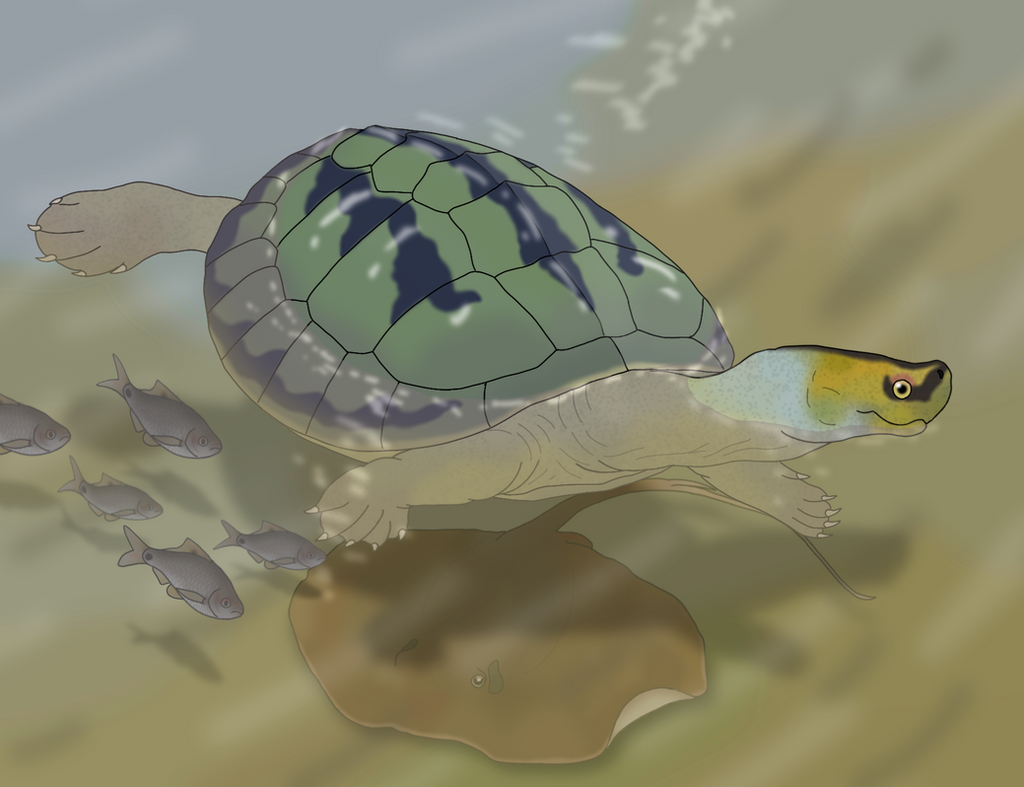HOME | DD
 Olmagon — Chindwin Creatures
Olmagon — Chindwin Creatures

#cyprinidae #cypriniformes #geoemydidae #geoemydid #batagurtrivittata #animal #animalart #animaldrawing #aquatic #aquaticlife #chelonian #endangered #endangeredanimals #endangeredspecies #fish #freshwater #reptile #river #stingray #turtle #wilderness #wildlife #wildlifeart #puntius #chondrichthyes #batagur #makararaja
Published: 2022-08-30 22:48:29 +0000 UTC; Views: 7420; Favourites: 147; Downloads: 5
Redirect to original
Description
In the shallow edges of the Chindwin River of Myanmar, a male Burmese roofed turtle (Batagur trivittata) partially submerged in the water swims over a Chindwin cowtail ray (Makararaja chindwinensis) which lies on the sediment at the bottom, while a small shoal of pool barbs (Puntius sophore) swim past.Drawing made for another Animal of the Month from the Wildlife--Awareness group, with the feature species this month being the Burmese roofed turtle. And I also threw in some other species it coexists with to make the picture a bit more interesting.
A large freshwater turtle, with shells reaching over 60 centimeters long, the Burmese roofed turtle is found only in the southeast Asian country of Myanmar, mainly around the Chindwin River. Young individuals have a ridge of spines on the top of their shells as well as serrated shell edges, but as the animal ages these become reduced and the carapace becomes smoother. During the breeding season, the heads of adult males become more brightly-colored and prominent black markings develop. Unfortunately, like all members of the genus Batagur, the Burmese roofed turtle is critically endangered due to pollution of its freshwater habitats and overexploitation of both eggs and adults for trading as food and for their shells. In fact the population dropped so severely that the species was believed extinct until the shell of a freshly killed and eaten one was found in 2001, and more live individuals have popped up since then. Fortunately some of these individuals were taken in for captive breeding to replenish the population, and while the species is still under threat, there are currently over 1,800 captive-bred individuals, with plans for releasing them into the wild underway.
A variety of fish are also found in the Chindwin River. One of the more common shoaling species is the pool barb, also called the spotfin swamp barb or stigma barb, found in freshwater habitats throughout south and southeast Asia, and is plentiful enough that it is commercially fished in some areas. Whilst rare in freshwater environments, chondrichthyes (cartilaginous fish, such as sharks and rays) are also known from this river. Described in 2007, the Chindwin cowtail ray is the only known species of the genus Makararaja, and known only from the Chindwin River. Only first known to western science when a specimen was collected in 2003, it is well-known to local fishermen. Whilst other freshwater stingray species are known from tropical rivers across the world, Makararaja is unrelated to any of them directly, and instead is most closely related to the marine cowtail stingrays of the genus Pastinachus, and represents yet another known instance of stingrays evolving to live in freshwater.
Related content
Comments: 10

👍: 0 ⏩: 1

👍: 0 ⏩: 0

👍: 0 ⏩: 1

👍: 0 ⏩: 1

👍: 1 ⏩: 1

👍: 0 ⏩: 0

👍: 0 ⏩: 1

👍: 0 ⏩: 0























